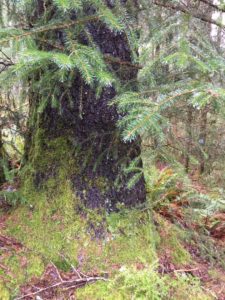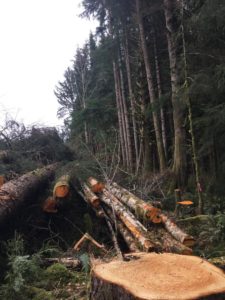

Before and After pictures are supposed to be uplifting, right?
In advertising parlance, they’re testimonials. But unlike those short quotes endorsing a product, these testimonials work visually, which is what makes them so striking and effective. The jumbo man in the jumbo pants is transformed into an average man holding up his now-roomy trousers, extolling the miraculous intervention of Acme Pounds-Be-Gone.
Ads like these rely on the viewer/consumer’s unspoken agreement that the “you” in the After picture is the most desirable “you” to be. We must pity the poor plump Before man and cheer for the slim new After man. Before: our horrifying, primitive, unregenerate, savage original self. After: our admirable, improved, refined, perfected self, not redeemed by faith or by works but by the power of the pocketbook…or more accurately, the power of marketing to get us to open the pocketbook and dole out the dollars for this New, Improved Self.
Worm-like, consumerism slithers along to hide its ugly underbelly. The weight pill doesn’t work; the big man and the average man are two different people; the average man’s cholesterol levels turn out to be worse than the big man’s. Many times, the Before picture proves lovelier, more whole and magical and wonderful, than the After picture. It all depends on how well we’ve been sold on the idea that anything natural must be repackaged, retrofitted, or renovated. The same firms that have sold us the notion that the human body is born ugly but improvable, as long as you buy the right redemptive products, has also convinced us consumers that the natural world is nothing but a vast discount supermarket designed for the sole purpose of furnishing privileged members of the human species with life’s luxuries, um, necessities.
Or maybe it’s a hybrid between a discount supermarket and an industrial park.
The land that the county plat map calls “mine” (stolen from its original inhabitants and cut over at least once by 19th-century Paul Bunyans) butts up against a logging company’s land. We weren’t sure where our tract ended and the logging company’s began, but once we became familiar with the 21st-century forest management’s accelerated cutting cycle (I love that expression, “forest management”—a natural, unrepentant forest can’t stay that way; it needs guidance, and power tools), we knew that someday we’d discover the boundaries in the starkest possible way. One day, we’d hike up our hill and discover a line the forest hadn’t drawn for itself: downed trees on one side, the trees they spared on the other.
A week or so ago, it happened. The line appeared. Trees disappeared. Before, After.
We had warning. Last summer, we encountered a surveying crew painting blue blazes on trees, setting stakes in the ground, and tying orange streamers to branches. A few weeks after that, the orange “Cutting Boundary” signs showed up, nailed to a blue-striped tree. A couple months ago, somebody parked a feller-buncher in a pull-out on the logging road just above where our path emerges onto the gravel. We heard chainsaws and the warning whistle going “poop-poop.” I jogged up the hill and took what I knew would, all too soon, be the Before pictures of the flagged boundary where “our” forest merged with “theirs.”
Last week, we noticed that when we looked up at the hill from outside our house, too much light and space shone back at us from the forest. So, apprehensive and anticipating doom, we hiked up the hill and came face to face with scorched earth: the After picture.
Two Sitka spruces from the grove we’d loved, left standing but wounded, perhaps because with their twined roots, they’d be a conundrum to cut. Churned-up earth. Stumps. The intact trees leaning in toward the new edge where trees we’d known now lay piled as logs, the front lines staring down at no-man’s (no-tree’s?) land.
Over the past year or so, I’ve been reading extraordinary books informing the non-scientist reader just how intelligent, purposeful, resilient, and even generous trees can be. Forester Peter Wohlleben’s The Hidden Life of Trees (Greystone, 2016) and tree scientist Diana Beresford-Kroeger’s The Global Forest (Penguin, 2010) describe how trees communicate chemically with one another. They release compounds to encourage plant growth around them (and not just any plants but specific pioneer species) and to transform meadows into groves and eventually forests. They share nutrients through root networks, the more fortunate trees nurturing the less fortunate, whose seeds took root in more arid, nutrient-depleted soil than their relations’. They defend themselves from insect attacks, manufacturing toxins that dissuade more chomping.
Forest biologist and member of the Potawatomi Nation Robin Wall Kimmerer, author of Gathering Moss (Oregon State University, 2003) and Braiding Sweetgrass (Milkweed, 2013) celebrates the vegetal wisdom by which intact forest communities regulate themselves (no human managerial staff necessary). She also provides a hope-filled perspective that fuses rather than separates bioscience and indigenous wisdom.
What moves me most about these books is how they demonstrate that trees are intentional beings, not through misty mysticism but through research grounded in the scientific method. Such—not just insights but findings—provide those who speak for trees with new evidence that the forest can and should stand on its own, that two hundred and more years of interventionist, industrial forestry must segue into something wiser, kinder, and sustainable for generations, not just for fleeting profits and a new treated-wood deck attached to every home.
I realize that I, raised in the Western European intellectual tradition, have fashioned an untenable binary here: forest as strip mall/strip mine versus forest as wilderness, with “Keep Out” signs aimed at humanity. Can a middle way be found, where nature invites humans back into the biosphere, as inhabitants and caretakers, not tourists or invaders? Can human thriving become compatible with non-human wisdom, beauty, life—and even rights?
It’s difficult to reconstruct perspectives from indigenous peoples who’ve lived in a healthier balance with their land, what with the absence of written records by the people rather than about them, in the conquerors’ language. There’s that imperial tendency either to denigrate another society in order to justify subjugating it, or to reify that society through images like the Noble Savage or the Last Mohican when the conquerors have done enough damage to nullify the threat those alternative ways represent to their status quo. Despite these genocide-fueled difficulties in restoring the historical record, both indigenous and settler peoples can learn how the First Americans interacted with, honored, and participated in their environments for human and non-human benefit. The first European immigrants didn’t arrive on a wild shore. They landed in the midst of a community where East Coast native peoples farmed, hunted, and forested in ways that would only centuries later be labeled sustainable. With that seven-generation ethic, native peoples invented sustainability.
Diana Beresford-Kroger describes how people living in what became the upper Midwestern states encouraged stands of different walnut tree species to grow, and they and other beings benefited from this natural super-food. These groves weren’t wilderness, but they weren’t factories either. They were orchards, cared for and harvested by many different species, humans included. In the Pacific Northwest, seafaring peoples sought out huge fallen cedars to use for boat-making and considered these life-giving trees family members. As Onandaga Chief Oren Lyons testified at the United Nations in 1993, “We don’t call a tree a resource. We don’t call a fish a resource. We don’t call a bison a resource. We call them our relatives.”
Respecting nature’s balance, while ensuring human flourishing, is neither an extinct philosophy nor romanticized ahistoricism. People have done it before; in many places, people still do it. Such practices can save the world, and our industrialized, commercialized society needs to sit up and take notice. There’s still time to save our forests and ourselves—and to create a whole different After picture.
Thank you Margaret for giving voice to a grief that burdens the hearts of many Oregonians. On public lands, especially, our forest practices need to be improved so that natural treasures are conserved for the long-haul. Our economy will self-destruct if people stop caring about ecology.
Thank you, Watt! That’s an important point to remember about the local economy, when this question is so often framed in simplistic terms of economic development versus environmental preservation. When we take the long (generational) view, that’s when we realize that environmental preservation ensures a sound economy.
I’m so sorry for your loss.
My husband, son, and I hiked in to check on a mushroom patch last week. It too was gone. A slash pile stood where the best chanterelles we’d ever found had been.
Thank you, Ann, and I’m so sorry that you lost your beautiful mushroom patch. As an avid mushroomer, I’ve read intriguing things about how fungal mycelium functions as a regulatory/intelligence system of the forest, and it’s one of the casualties of clear-cutting and other destructive industrial forestry practices. The damage isn’t just above ground…
It’s so important for us to make ourselves a part of wilderness, for that’s how become a part of the wild community and fall in love. I allow myself to care about specific groves, specific paths, specific trees, and the creeks they nurture. Grieve when the damage is done but speak for the trees too. So thank you Margaret for your words, your insight, your shared grief. You are so right that we need to save the trees and ourselves.
Thank you, Jennifer, for your beautiful insight about the intertwined fates of human beings and trees. It’s an extraordinary symbiosis, how animals and plants share in the respiratory cycle, exchanging oxygen and carbon dioxide.
Thank you also for sharing your experiences in bonding with trees and places. When we make friends with another person, we grieve the loss of that friendship to death, moving away, and other separations; the same is true of our friendships with trees. I grieve for my Sitka spruce and red alder friends lying at the side of the path, stacked up and ready for transport.
I’m amazed about the things I’ve read about trees caring for each other as well. Perhaps some of the stumps behind our forest may survive and send up shoots because healthy trees nearby are still sending nutrients to them through their shared root network. Wow, talk about a supportive community.
Wood can be sustainably harvested without clearcutting. Clearcutting is laziness, pure and simple, profit above all other considerations. Logging companies want the freedom to enter a forest and do whatever they want without having to be ‘careful’ or ‘considerate’. Meanwhile other parts of the country and world use some nearly 20 alternative methods for harvesting wood that doesn’t decimate an ecosystem. We can have logging *and* have a healthy ecosystem that can see other recreational uses. It doesn’t have to be an either-or situation.
John, thanks so much for addressing sustainable forestry practices. I recently read The Hidden Life of Trees, and the writer is the caretaker for a community forest in Bavaria, Germany. They practice thinning and selective cutting, leaving most of the forest to continue growing. It’s not only respectful of the trees as organisms but also supports the surrounding human community economically. I’m eager to learn about other forestry models besides clearcutting and slash-and-burn.